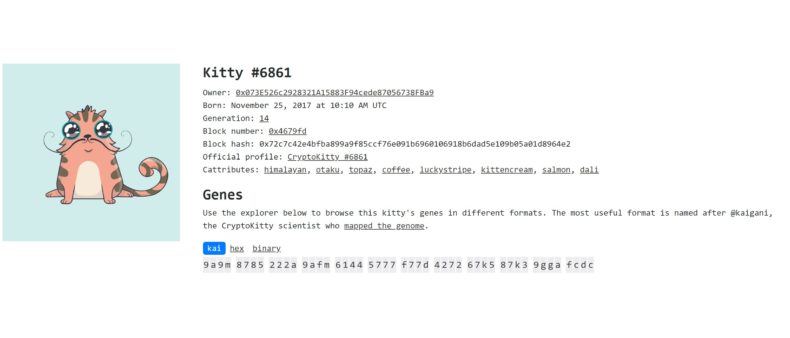Not all cute-but-scary animals are biological. Allow me to expand the remit of Snark Week to include the dreaded CryptoKitty. Adorable and fluffy? Absolutely. Existentially dangerous? Most certainly.
This creature packs a triple punch. Once critically endangered, it is now trying to claw its way out of jeopardy – on the back of a real-life endangered animal. But we mustn’t let it. You see, if it succeeds, the next endangered species could be us.
You wouldn’t think an animal made only of 0s and 1s would be capable of such malevolence. A CryptoKitty is a purely digital phenomenon: part cat, part cryptocurrency, it started as a putative solution to one of the most fundamental limitations on the internet. How do you give value to the immaterial, infinitely duplicable stuff of the internet? This question is as salient for art as it is for money: normally if you create a piece of art and put it on the internet, any tech billionaire can come along and swipe it for his personal brand. This is part of what has kept digital art value-free. Which makes sense. How do you ensure people know you made this thing? How can the person who buys your art display it or “own” it in any meaningful way without having it ripped off by anyone who can do a screenshot?
Some enterprising people discovered that you might solve the problem by putting works of art on the same unalterable chassis that supports cryptocurrencies: the blockchain. Several art-oriented blockchain projects have launched in the past year, attracting what the Financial Times calls “enthusiasts curious about blockchain’s novel potential to affix value to digital art by making it rare and unreplicable.” Even Christie’s, that grandee of auction houses, is sniffing around the blockchain to take fine art into the 21st century.
But who has time for all this hifalutin art stuff. The thing that got regular people excited about monetizing art on a blockchain were some lowbrow collectibles best compared to digital beanie babies. You remember beanie babies. Some people took them very seriously.
1999: A divorcing couple divides their Beanie Baby investment under the supervision of a judge.
CyptoKitties were poised to be the heirs to that throne. They are cartoon critters whose digital DNA means no are two alike. To get them, you pay Ethereum, which is a digital currency like Bitcoin, but which runs on a different kind of blockchain controlled by different people. You can collect CryptoKitties, customize them, and breed them – two CryptoKitties can spawn a new one. The whole thing is a fun little game. But they are protected by their unique identifiers on their blockchain.

By December, hundreds of thousands of CryptoKitties were flying off the Ethereum shelves. Their median price hit $41 a cat, which doesn’t reflect the outrageous prices some of these things commanded – one specimen fetched more than $100,000.
Anyone with a passing familiarity with the internet or bubbles knows what happened next – the whole edifice came tumbling down, sending the median price of a CryptoKitty down to $5. The fickle People of The Internet lost interest.
But then – two weeks ago, not long into their endangered status, the people who run CryptoKitties teamed up with an entity that fights for endangered sea turtles, reports The Next Web:
Recent partnerships formed between CryptoKitties and wildlife conservation groups mean that all proceeds go directly to help endangered sea turtles in Antigua, Barbuda, and the British Virgin Islands.
A specially commissioned CryptoKittiy called Honu was auctioned off for $25,000 to to call attention to the plight of these animals. Or is it the other way around? Are the CryptoKitties trying to use these poor sea turtles to hitch a ride back to relevance?
It’s hard to say.
What’s certain is that if these turtles save the CryptoKitty, it will show its gratitude by destroying the world!
You’ve probably heard all the handwringing about Bitcoin’s energy footprint; a single bitcoin transaction requires the amount of energy used to power nine homes in the U.S. for one day; Iceland uses more energy mining bitcoin than powering its homes. While the exact figures are now a matter of some debate, mining Bitcoin is indisputably energy intensive, and it’s down to the way authenticity is conferred.
CryptoKitties use the Ethereum blockchain, which is different to the one that powers Bitcoin, but they all work essentially the same energy-intensive way. Even Ethereum’s vaunted Casper update – celebrated in many news media accounts as a way to bring down the energy consumption – won’t solve the blockchain energy crisis. Quoth TechCrunch:
“Casper will not fix the power consumption or GPU scarcity issues that have been a consequence of Ethereum’s rise.”
The upshot: if CryptoKitties return once more to wild popularity, and breed at their previous levels, it won’t be long before they use most of the world’s energy to make more of themselves, leaving the Earth a burned out husk populated only by doe-eyed digital felines. Are you enjoying the northern hemisphere’s nuclear summer? You want more? Then by all means, invest in a CryptoKitty.
Photo Credits:
Cats in Human Costumes, Utagawa Kunisada II, Wellcome Collection
One of the CryptoKitties from the KittyDex
Can’t get enough Snark? Why not graze on the terrifying tales of Snark Weeks past:
Snark Week 2017, featuring abusive blackbirds, an immense, near-spherical raccoon, and the vile creature that will gnaw on your soul – and then poop on it.
Snark Week 2016, featuring testicle-eating assassins, chihuahua terrorists, and the animals so vile they come out of the womb with horns.
Snark Week 2015, featuring flesh-ripping alien fleas, bovine murderers, and the unfairly beloved animal whose terrifying extra neck vertebrae allows them to turn their terrifying neckheads 270 degrees.
Snark Week 2014, featuring squirrels hell bent on world domination, more feral roosters, and a furry virus that has spread across the United States to total devastation.
Snark Week 2013 – the very first! – featuring the ant that kills cows, the bird responsible for five deaths and $425 million in damages, and an animal so vicious he is known only as Little Red Bastard.

God. The heart weeps.